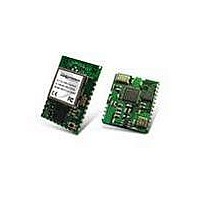WI.232FHSS-250-R Radiotronix, WI.232FHSS-250-R Datasheet - Page 37

WI.232FHSS-250-R
Manufacturer Part Number
WI.232FHSS-250-R
Description
RF Modules & Development Tools 900MHz FHSS Low
Manufacturer
Radiotronix
Datasheet
1.WI.232FHSS-25-FCC-RA-R.pdf
(67 pages)
Specifications of WI.232FHSS-250-R
Lead Free Status / RoHS Status
Lead free / RoHS Compliant
Other names
WI232FHSS-250-R
WI.232FHSS-25-R/ WI.232FHSS-250-R DATASHEET
Troubleshooting Hint: Baud Rate Problems. If you lose track of the baud rate setting of the module, it will
be impossible to program the module. You can either try every possible baud rate to discover the setting,
or force a power-on reset with CMD held low to set the baud rate to its default: 2.4kbit/second.
Default Network Mode: MAC Mode
The module supports three distinct networking modes, MAC, USER, and Extended USER, configured
through bits NM0 – NM2. For each of these modes, assured delivery (acknowledgement) can be either
enabled or disabled. For more information, see Addressing Modes section of this manual. Valid settings
are listed in the table below.
Wi.232FHSS-250-R version 1.1.0 and greater firmware support an additional flag, EP0 (force extended
preamble). This flag forces the module to send an extended preamble on every RF transmission. An
extended preamble is of a length that allows modules that have just awakened or have not yet
synchronized to find and temporarily synchronize with the transmitting module. This can be useful in
systems that require the endpoints to spend most of their time sleeping. Endpoints can awaken, receive
an application-defined message from the master transmitter, and go back to sleep. This message could
contain scheduling information as to when to wake again for a full bi-directional communications session.
It is important to note that extended preamble RF packets are not necessarily RF synchronizing packets.
Upon completing the reception of an extended preamble RF packet that is not a synchronizer, the receiving
module will lose its temporary synchronization and begin looking for another extended
preamble/synchronizer on another channel.
Table 13, Network Mode Register Settings
All other network modes are reserved and may cause undesired operation.
Troubleshooting Hint: If you are unable to communicate with another module, it is most likely one of
following problems. First, check to make sure that you are using the same data rate. Modules
programmed to different data rates will not communicate nor share the RF channel with one another.
Second, ensure that your network mode and addressing is configured to properly access the module of
interest. Also, ensure that you are addressing a specific module when using acknowledgment. Failure to
do so will cause large delays and loss of data.
R/W
N/A
7
Network Mode
0x04
0x05
0x06
0x07
0x14
0x15
0x16
0x17
4.1.5. Network Mode (regNETWORKMODE)
regNVNETMODE (0x04)
R/W
N/A
6
Meaning
MAC Address Mode
Reserved
User Address Mode
User Extended Address Mode
MAC Address Mode with Acknowledgement
Reserved
MAC Address Mode with Acknowledgement
User Extended Address Mode with Acknowledgement
R/W
N/A
5
R/W
RA0
4
36
EP0
3
R/W
R/W
NM2
2
regNETMODE (0x4F)
R/W
NM1
1
Revision 1.1.0
R/W
NM0
0













